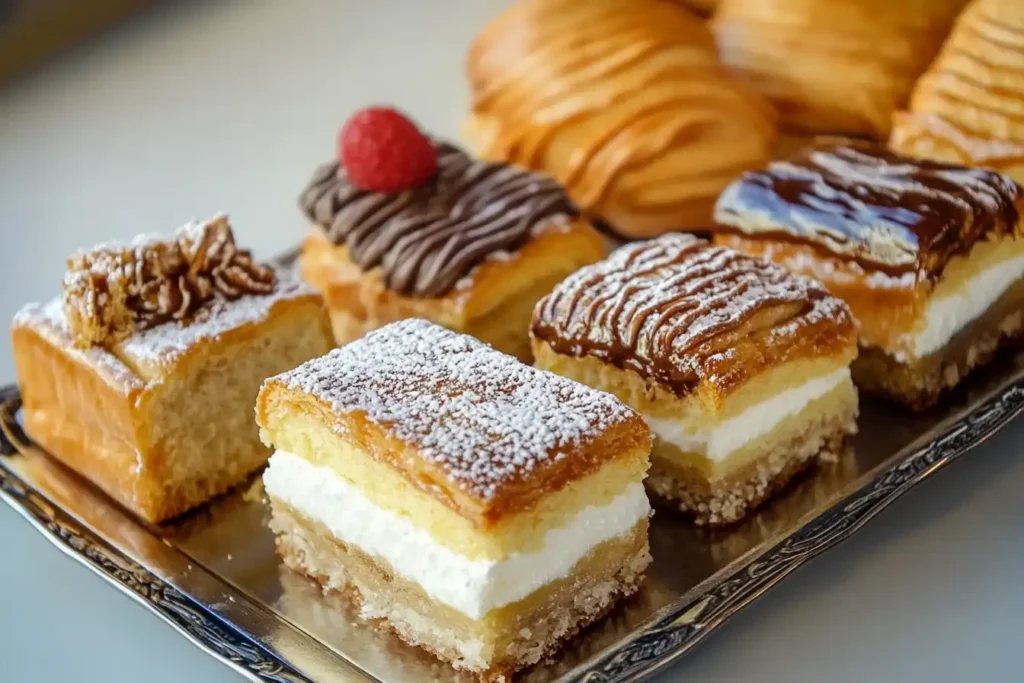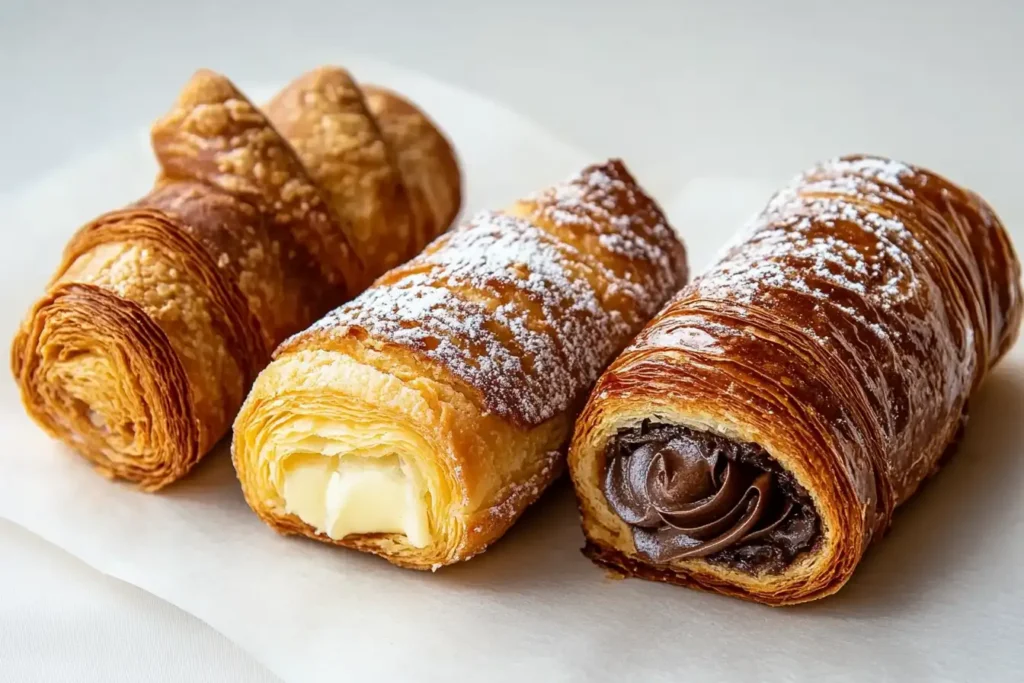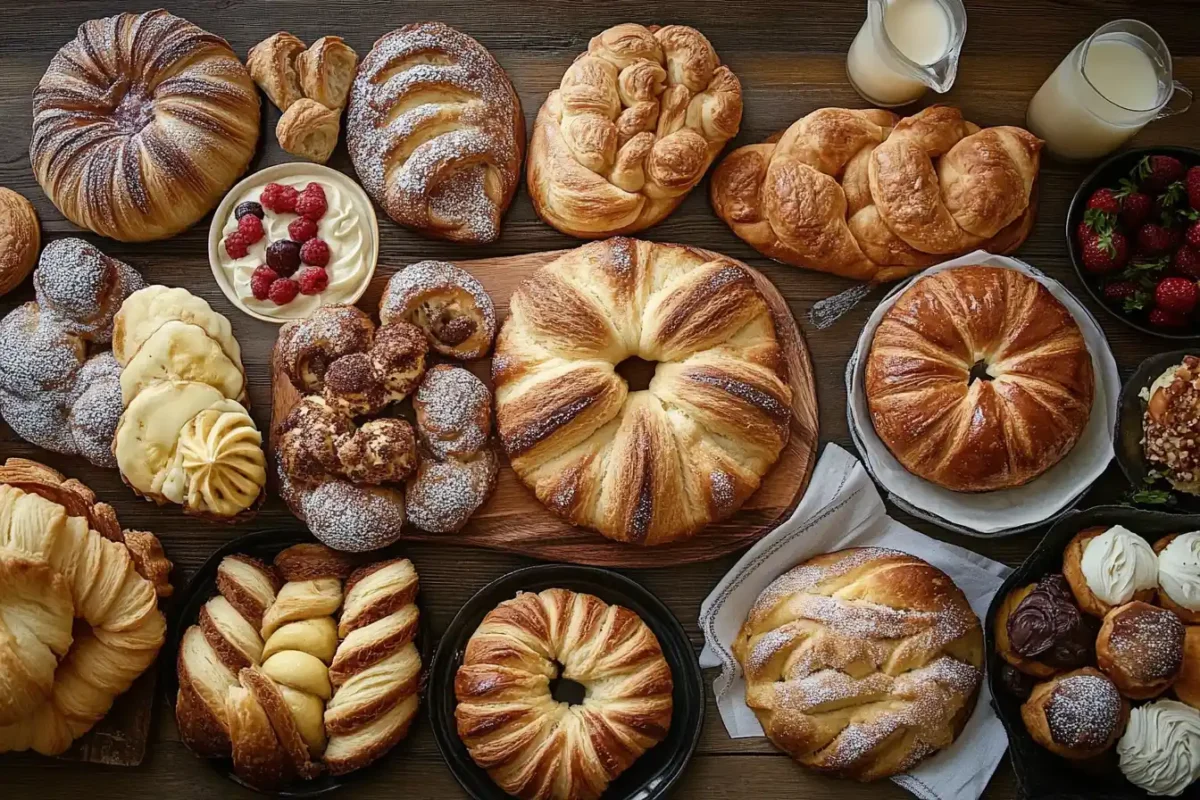Let’s explore what the five main types of pastries are. We will cover their origins, key characteristics, and why people love them so much.
Pastries are a beloved part of culinary traditions. From simple snacks to elaborate desserts, they offer something for everyone. But what are the 5 main pastries that stand out? Let’s dive in and discover them.
What Are the 5 Main Pastries? Exploring the World of Baked Delights
Firstly, understanding the five basic pastries requires examining a range of baking styles. Each one has a unique texture, flavor, and purpose. This overview will cover the fundamental pastry types.
1. Shortcrust Pastry: A Foundation for Many Treats
Shortcrust pastry is one of the five main pastries. Moreover, it forms the base for many dishes. The ingredients are usually simple: flour, butter, and sometimes a little water. Its texture is crumbly and tender. Bakers mostly use it in pies, tarts, and quiches. Shortcrust pastry works well with both sweet and savory fillings. Therefore, it is a highly adaptable option. Consequently, home bakers often choose it.
How to Make Perfect Shortcrust Pastry
Making shortcrust pastry requires attention to technique. Firstly, use cold ingredients. This prevents the butter from melting too soon. Secondly, cut the butter into the flour. Use your fingertips or a pastry blender. Then, add a little cold water until the dough comes together. Don’t overwork the dough, or it will become tough. Finally, let it rest in the fridge. This helps relax the gluten, making it more tender. Specifically, resting time is crucial for a flaky crust.
2. Puff Pastry: Light and Airy Layers
Another of the five basic pastries is puff pastry. People know it for its light, flaky texture. Bakers make it using many layers of butter and dough. The process takes time. However, the results are worth it. Puff pastry goes into croissants, mille-feuilles, and other delicate treats. It bakes up light and airy, with a lovely crispness. Furthermore, it is ideal for recipes requiring an elegant touch.
The Art of Creating Puff Pastry
Making puff pastry from scratch is hard work. However, the result is stunning. The key is to fold and roll the dough multiple times. This creates many thin layers of butter and dough. As it bakes, the moisture from the butter turns to steam. Therefore, the steam separates the layers, creating the light, airy texture. This method requires patience. However, it is rewarding. Indeed, the process of laminating the dough is quite meticulous.
3. Choux Pastry: A Versatile Option
Choux pastry is among the five main pastry types. This one stands out as it is very different. It’s not a flaky pastry, but rather a light, airy dough that cooks on the stovetop first. The main ingredients are water, butter, flour, and eggs. After cooking on the stovetop, bakers bake it. As it bakes, it expands into hollow shells. Thus, choux pastry makes cream puffs, éclairs, and profiteroles. The unique texture makes it ideal for fillings. Moreover, its versatility extends to both sweet and savory applications.
Mastering the Choux Pastry Technique
The process starts by melting butter in water. Add the flour quickly. Stir until a smooth dough forms. This step is very important. Then, cool the dough slightly before adding the eggs. Beat them in one at a time. Then, pipe the dough and bake it. The result is a light and airy shell that is perfect for creams and custards. The method is not too complicated. Moreover, the results are very impressive. Accordingly, attention to detail is key for success with choux pastry.
4. Phyllo Pastry: Thin and Delicate
Phyllo pastry is another key part of what are the 5 main pastries. These very thin sheets of dough form flaky crusts when layered. It is incredibly delicate and almost paper-thin. The dough itself is very simple. However, it requires a lot of care to handle. Phyllo pastry is common in Greek and Middle Eastern dishes. These include baklava and spanakopita. It adds a satisfying crispness to many baked goods. Additionally, people often use it to create visually impressive dishes.
How to Handle Delicate Phyllo Pastry
Phyllo pastry needs gentle handling. The sheets dry out very fast. Thus, keep them covered with a damp cloth. Use butter or oil to layer the sheets. This adds richness and helps them crisp up when baked. The results are layers that are delicate and light. Thus, handling this pastry requires a delicate touch. Likewise, it’s important to work quickly and efficiently.
5. Danish Pastry: Rich and Buttery
Finally, what are the 5 main pastries includes Danish pastry. This is a sweet, rich dough. Bakers often layer it with butter like puff pastry, but they also enrich it with eggs and sugar. The resulting pastry is flaky, yet tender. Bakers often fill it with fruit, cream cheese, or custard. Danish pastry is a favorite for breakfast or brunch. It has a balance of sweet and buttery flavors. Furthermore, you can easily customize it with different fillings and toppings.
Making Delicious Danish Pastries
Making Danish pastry is a process that takes time. The dough has eggs and butter for richness. Bakers then layer and roll it similar to puff pastry. They repeat this process many times. However, each step is important. Finally, they fill and bake the pastries. The result is a delicious treat. The texture is flaky and tender. Therefore, this baking process is a labor of love, with great results.

How the 5 Main Pastry Types Are Used
These five basic pastries are versatile and very common. They form the foundation of many different desserts. They also have different uses in savory recipes. For instance, shortcrust works very well for a savory pie. Puff pastry adds a touch of sophistication to appetizers. Choux pastry offers a light base for many fillings. Phyllo gives a crispy texture to savory dishes. The richness of Danish pastry is perfect for sweet treats. Understanding the differences between each will help you become a better baker. Undoubtedly, mastering these skills will improve your culinary abilities.
The Importance of Understanding Different Pastries
Knowing what are the 5 main pastries provides a very useful base of knowledge. Firstly, you can make a wider range of recipes. Also, you can understand the science behind each one. Therefore, this will improve your baking results. Moreover, this will expand your cooking options. Hence, a good understanding of these pastries is essential for aspiring bakers.
What Are the 5 Main Pastries and Their Unique Characteristics
Each of the five main pastry types has its own qualities. Shortcrust pastry is known for its crumbly texture. Puff pastry is all about light, airy layers. Choux pastry creates hollow shells perfect for fillings. Phyllo pastry adds a crisp texture to layered dishes. Finally, Danish pastry is rich and buttery. These differences make them suitable for various recipes. Choosing the right one is essential for a successful dish. Especially, when planning out a detailed recipe.
Baking Tips for Each of the 5 Main Pastries
Baking each of the five basic pastries requires certain techniques. Therefore, follow these tips to improve your results. Shortcrust pastry requires cold ingredients and gentle handling. Puff pastry needs proper folding and rolling. Choux pastry needs to cook on the stovetop first. Phyllo pastry needs to be kept moist and layered with fat. Danish pastry needs a rich dough and proper layering. Also, keeping the oven temperature correct is very important for all of them. Eventually, these practices will become second nature, with practice.
Understanding the Role of Ingredients in Pastry Types
Each pastry type depends on its ingredients. Flour gives structure. Fat gives tenderness. Water creates steam. Eggs add richness and structure. Sugar adds sweetness and color. Understanding how each ingredient works will give you control over the final texture. Consequently, you can easily achieve the desired result. Explicitly, understanding the function of each ingredient is critical.
The Importance of Temperature in Pastry Making
Temperature is very crucial for pastry making. The temperature of ingredients matters a lot. For example, cold butter is very important for shortcrust and puff pastries. The oven temperature has a big effect on baking results. It needs to be correct to achieve the best possible result. Thus, you need to use an oven thermometer. Generally, the correct temperature control can make or break a pastry.
Pastry Types in Different Cultures
The five basic pastries appear in many cultures. Each culture has its own take on these favorites. Shortcrust is the basis for many pies. Puff pastry is very popular in France. Choux pastry is a classic in French desserts. Phyllo pastry is a staple in Greek and Turkish treats. Danish pastries have their origins in, of course, Denmark. Therefore, you can find variations of these pastries everywhere. Comparatively, each culture has adapted these pastries to fit their own culinary traditions.
The Evolution of Pastry
Pastry making has changed over time. From ancient times to today, bakers have refined techniques. Chefs are always experimenting with new ideas. However, the basic principles of these pastry types remain the same. Pastry has become an important part of our food culture. Subsequently, it continues to evolve through innovation and creative experimentation.
Combining Different Pastry Types
Bakers often combine pastry types for more complex creations. For instance, they might use puff pastry as a top for a shortcrust pie. This adds layers of textures and flavors to a single dish. It is a great method to enhance the dish’s complexity. This is a common approach for experienced bakers. Specifically, this technique allows for endless creativity in the kitchen.
Why These Five Main Pastries Are So Popular
The five main pastries are popular for their textures. They also have versatility and the satisfying experience they offer. From the tenderness of a shortcrust to the flakiness of a puff pastry, there’s something for every preference. These options have become classics for good reasons. The fact that you can use them for sweet and savory recipes is also a factor. Moreover, their accessibility and ease of variations make them a favorite among home cooks.
Advanced Techniques and Tips for Pastry Making
Mastering the five main pastries is just the beginning. There are also many advanced techniques to explore. These techniques range from perfecting the lamination in puff pastry to creating intricate designs in Danish pastries. Initially, consider exploring different flours and fat types to create different flavor profiles in your pastries. Learning advanced piping techniques can also elevate your pastries to the next level. Furthermore, understanding the science behind gluten development is essential for achieving the perfect pastry texture. Eventually, through continuous learning and practice, one can significantly improve their baking skills.
Troubleshooting Common Pastry Making Issues
Baking pastries can be tricky. There are also many common problems that can arise. Shortcrust pastry can become tough. Puff pastry may not rise correctly. Choux pastry may collapse. Phyllo pastry may become too dry. Therefore, troubleshooting these issues requires experience. However, with practice, you can master these techniques and achieve better results. Also, using accurate measurements and precise oven settings can help prevent mistakes. Likewise, learning to recognize the signs of properly formed pastry dough can prove to be very beneficial.
The Cultural Significance of Pastry
Pastry isn’t just food. It’s also deeply rooted in traditions and celebrations. People use many pastries for specific occasions. For example, a pie for Thanksgiving, or croissants for a leisurely Sunday breakfast. Pastry also has the power to evoke memories and connect us to our past. Indeed, it’s clear that pastry holds a very special place in our collective food heritage.
Pastry Pairings and Serving Suggestions
The world of pastry pairings can greatly enhance the enjoyment of these culinary delights. Specifically, consider pairing a rich, savory pie with a light salad. Serve croissants with fresh fruit and yogurt. Pair choux pastry with a delicate custard filling. Furthermore, consider serving phyllo pastry with a flavorful cheese and spinach filling. Serve Danish pastry with a side of coffee or tea. Additionally, garnishes such as a simple dusting of powdered sugar or a fresh fruit topping can further elevate the experience.
Preserving and Storing Pastry
Proper preservation and storage of pastries are crucial for maintaining their texture and flavor. Shortcrust pastries are best in an airtight container to prevent them from drying out. Puff pastries should be in a cool, dry place to prevent them from becoming soggy. People best enjoy choux pastries soon after making them, but you can store them in an airtight container if needed. Phyllo pastries should be in a dry place. Finally, Danish pastries are best consumed fresh, but you can freeze them for later use. Therefore, proper storage is essential for enjoying the quality of each pastry.
The Future of Pastry
The world of pastry is always evolving. Bakers constantly experiment with new flavors. They also try new techniques and presentations. There’s a growing demand for healthier options and innovative ingredients. Indeed, the future of pastry is exciting, with new trends and ideas emerging constantly. Ultimately, the appreciation of pastry continues to grow, as chefs and home bakers refine their methods and expand the boundaries of baking.

Conclusion: Mastering What Are the 5 Main Pastries
In conclusion, knowing what are the 5 main pastries is a must for any baker. Each pastry has its own unique qualities. Shortcrust, puff, choux, phyllo, and Danish pastries all contribute a lot to baking traditions. They all offer different textures, flavors, and uses. Mastering these pastry types will make you a better baker. Hence, you will be able to make a greater range of dishes. These five options form the base for countless delicious recipes. Essentially, having this knowledge will greatly expand your culinary expertise.

